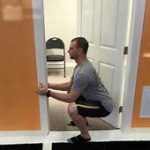Exercise of the Week: Squat

Luke Lewitzke
Certified A.C.E. (American Counsel on Exercise) Personal Trainer
Weight and Lifestyle Management Specialist
The squat is a primary movement that we do in everyday life. The squat primarily works the glutes, quadriceps, hamstrings, adductors (inner thigh), core and spinal erectors. The glutes, quadriceps, and adductors primarily work as you stand back up, while the hamstrings work to help control your knee flexion as you lower down and help with hip extension on the way up. Your core and spinal erectors are going to work the entire time to maintain a strong posture and protect the spine through the exercise.
Muscles Worked
- Stand with your feet hip-width to shoulder-width apart.
- Brace your core and lift your arms until they are parallel to the floor.
- Keeping your chest proud and without using your hands, sit your hips back and down, sitting in a chair, while maintaining a tall posture through the spine.
- Try to keep your arms parallel to the floor instead of dropping or pointing to the floor.
- Note that the angle of your torso (hips to shoulder), should be the same angle as that of your lower legs (ankle to knee).
- Push your feet into the floor and stand back up.
- Perform up to 15 squats, starting with a low number and gradually increasing over time to 15. Rest for 30 seconds and then repeat.

Regressions
If when you squat, either your knees drive well beyond your toes putting sheer force into the knee, or your torso flexes too far forward putting strain into your lower back, you may want to regress to a wall sit to build strength and stamina in the legs or hold onto a door frame to make sure that you can maintain good form.


Contraindications
- Don’t perform squats if you experience sharp pain in your lower back.
- Don’t perform squats if you experience knee pain that affects your movement.
If you experience pain in either your lower back or your knees when squatting, try modifying your range of motion or try the regressions. Because we squat every day, whether sitting down on a chair or toilet, or getting in and out of our car, it is crucial that we continue to keep those muscles strong. To limit your range of motion, sit down in a chair. If that is still uncomfortable, raise the height of the seat by putting a pillow or cushion on it so you don’t have to sit as deep. As the legs get stronger and pain subsides, lower your seat level, or take the chair away all together.



